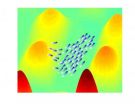(Press-News.org) WASHINGTON, November 17, 2011 -- Factors such as low hemoglobin levels, increased systolic blood pressure, and male gender are linked to a higher risk of silent cerebral infarcts (SCIs), or silent strokes, in children with sickle cell anemia (SCA), according to results from a large, first-of-its-kind study published online today in Blood, the Journal of the American Society of Hematology (ASH).
Silent strokes are the most common form of neurological injury found in SCA, with more than 25 percent of children with the disorder suffering a SCI by age six,1 and nearly 40 percent by age 14.2 Strokes occur in patients with SCA as a result of low hemoglobin levels in the blood. Because hemoglobin is responsible for carrying oxygen to the blood, the body compensates for low hemoglobin levels by increasing blood flow to the brain, raising patients' risk for brain injury, including these silent strokes.
"Young patients with a history of silent strokes have an increased risk of future overt strokes and new or increasingly severe silent stroke-related events, and have poorer cognitive function than children with sickle cell disease who have normal brain MRIs," said Michael R. DeBaun, MD, MPH, first author and initiator of the study and Director of the Vanderbilt-Meharry Center for Excellence in Sickle Cell Disease at Vanderbilt University. "Children with silent strokes have a much higher risk of poor academic performance, and over the long term, we see a higher proportion of these young adults requiring special education or being retained in school."
While silent strokes have been well documented in older adults, there has been limited research available to support clinical risk factors for silent strokes in children with SCA. In order to assess whether previously identified risk factors for silent strokes in the general population -- low hemoglobin, high systolic blood pressure, and male gender -- were also associated with an increased risk of silent strokes in patients with SCA, investigators analyzed data from the international, multicenter Silent Cerebral Infarct Multi-Center Clinical Trial (SIT Trial). The SIT Trial, which was supported by the National Institutes of Health (NIH) and the National Institute of Neurological Disorders and Stroke (NINDS), was designed to determine the efficacy of blood transfusion therapy for prevention of recurrent silent stroke events in participants with SCA.
In this cross-sectional study, investigators evaluated clinical history and baseline laboratory values and performed brain MRIs (to confirm silent stroke) in 814 children with SCA between the ages of 5 and 15 years with no history of overt stroke or seizures. Results from the data analysis showed that silent strokes occurred in one-third (251 of 814) of SCA patients enrolled in the trial. Further analysis demonstrated that lower concentrations of hemoglobin, higher baseline systolic blood pressure, and male gender were associated with a significantly increased risk of silent stroke.
"This study confirms our original hypothesis that risk factors for silent strokes in the general population are also risk factors for pediatric patients with sickle cell anemia," said Dr. DeBaun, also the JC Peterson Endowed Chair in the Department of Pediatrics at Vanderbilt University. "With these results, we can focus our research efforts on strategies to prevent these silent strokes in children with SCA."
Dr. DeBaun and colleagues are currently conducting additional research to determine if hydroxyurea, a treatment traditionally used to manage the pain episodes that occur with SCA, can also be used to prevent silent strokes in infants.
###
Kwiatkowski JL, Zimmerman RA, Pollock AN, et al. Silent infarcts in young children with sickle cell disease. Br J Haematol. 2009;146:300-305.
Bernaudin F, Verlhac S, Arnaud C, et al. Impact of early transcranial Doppler screening and intensive therapy on cerebral vasculopathy outcome in a newborn sickle cell anemia cohort. Blood. 2011;117:1130-1140; quiz 1436.
The American Society of Hematology is the world's largest professional society concerned with the causes and treatment of blood disorders. Its mission is to further the understanding, diagnosis, treatment, and prevention of disorders affecting blood, bone marrow, and the immunologic, hemostatic, and vascular systems by promoting research, clinical care, education, training, and advocacy in hematology. The official journal of ASH is Blood, the most cited peer-reviewed publication in the field, which is available weekly in print and online.
Study identifies 'silent' stroke risk factors for children with sickle cell anemia
2011-11-21
ELSE PRESS RELEASES FROM THIS DATE:
Squid mystery in Mexican waters unraveled by Stanford biologist and a class of students
2011-11-21
While shorter days and colder weather move many of us to hunker under the covers, researchers who spent their summers in fieldwork are more likely to be hunched over microscopes and curled over keyboards, scrutinizing samples and crunching data from their summer's labors.
One such researcher is marine biologist William Gilly, who spent a month last summer in Mexico's Sea of Cortez tracking the sometimes-elusive Humboldt squid. Researchers from several universities were on the voyage. Gilly is in the second year of a quest to understand the surprisingly strong impact ...
Separating signal and noise in climate warming
2011-11-21
LIVERMORE, Calif. -- In order to separate human-caused global warming from the "noise" of purely natural climate fluctuations, temperature records must be at least 17 years long, according to climate scientists.
To address criticism of the reliability of thermometer records of surface warming, Lawrence Livermore National Laboratory scientists analyzed satellite measurements of the temperature of the lower troposphere (the region of the atmosphere from the surface to roughly five miles above) and saw a clear signal of human-induced warming of the planet.
Satellite measurements ...
In an enzyme critical for life, X-ray emission cracks mystery atom
2011-11-21
ITHACA, N.Y. - Like a shadowy character just hidden from view, a mystery atom in the middle of a complex enzyme called nitrogenase had long hindered scientists' ability to study the enzyme fully.
But now an international team of scientists led by Serena DeBeer, Cornell assistant professor of chemistry and chemical biology, has pulled back the curtain using powerful synchrotron spectroscopy and computational modeling to reveal carbon as the once-elusive atom.
The research was published online Nov. 17 in the journal Science.
"For chemists, one of the first steps you ...
Environmental conditions and predators affect Atlantic salmon survival in the Gulf of Maine
2011-11-21
Stocks of Atlantic salmon (Salmo salar), which have been steadily declining for the past few decades, are facing new challenges in the Gulf of Maine, where changing spring wind patterns, warming sea surface temperatures and new predators along altered migration routes are affecting their survival.
In a paper published online in the journal Fisheries Management and Ecology, Kevin Friedland and co-authors suggest post-smolts are entering an increasingly warmer coastal ocean, where they are facing mortality risks associated with a changing climate, such as changing distributions ...
Researchers discover new way to form extracellular vesicles
2011-11-21
Researchers at NYU Langone Medical Center have discovered a protein called TAT-5 that affects the production of extracellular vesicles, small sacs of membrane released from the surface of cells, capable of sending signals to other cells. When released extracellular vesicles can affect tumor spread, blood clotting and inflammation. Their discovery gives new insight into how extracellular vesicles form, and reveals new potential strategies to manipulate diseases such as cancer. The study was published online November 17, 2011 in Current Biology.
"Very little is known ...
Micro-cavity arrays: Lighting the way to the future
2011-11-21
It was not too long ago that basic science lectures began with the three forms of matter: gases, liquids and solids—and somewhere along the line plasmas were occasionally added to the list. But to be precise, a plasma is an ionized gas; thus, a subset of the big three. But this subset has coexisted with the other forms since the Big Bang and actually makes up 99 percent of the universe. It is found in our Sun and all the other stars, and in more down to earth applications: in neon signs, Plasma TVs, Cathode Ray Tubes, and the ubiquitous fluorescent light.
It is now ...
Bleak future for Bay area tidal marshes?
2011-11-21
[San Francisco, CA] – A new study, led by PRBO Conservation Science (PRBO), projects a bleak future for San Francisco Bay's tidal marshes under high-end sea-level rise scenarios that are increasingly likely. PRBO and colleagues found that in the worst case scenario 93% of San Francisco Bay's tidal marsh could be lost in the next 50-100 years [with 5.4 feet or 1.65 meters of sea-level rise, low sediment availability and no significant restoration].
PRBO's study indicates, however, that not all marshes will be lost and that society's actions today, including restoration ...
Smart swarms of bacteria inspire robotics researchers
2011-11-21
Much to humans' chagrin, bacteria have superior survival skills. Their decision-making processes and collective behaviors allow them to thrive and even spread efficiently in difficult environments.
Now researchers at Tel Aviv University have developed a computational model that better explains how bacteria move in a swarm — and this model can be applied to man-made technologies, including computers, artificial intelligence, and robotics. Ph.D. student Adi Shklarsh — with her supervisor Prof. Eshel Ben-Jacob of TAU's Sackler School of Physics and Astronomy, Gil Ariel ...
Targeting bacterial gas defenses allow for increased efficacy of numerous antibiotics
2011-11-21
Although scientists have known for centuries that many bacteria produce hydrogen sulfide (H2S) it was thought to be simply a toxic by-product of cellular activity. Now, researchers at NYU School of Medicine have discovered H2S in fact plays a major role in protecting bacteria from the effects of numerous different antibiotics.
In the study led by Evgeny Nudler, PhD, the Julie Wilson Anderson Professor of Biochemistry at NYU School of Medicine, researchers found evidence that H2S acts as a general defense mechanism against oxidative stress, the process through which ...
NASA's Chandra adds to black hole birth announcement
2011-11-21
New details about the birth of a famous black hole that took place millions of years ago have been uncovered, thanks to a team of scientists who used data from NASA's Chandra X-ray Observatory as well as from radio, optical and other X-ray telescopes.
Over three decades ago, Stephen Hawking placed -- and eventually lost – a bet against the existence of a black hole in Cygnus X-1. Today, astronomers are confident the Cygnus X-1 system contains a black hole, and with these latest studies they have remarkably precise values of its mass, spin, and distance from Earth. With ...



